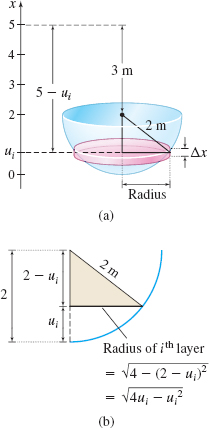EXAMPLE 5Finding the Work Required to Pump Water from a Tank
A water tank in the shape of a hemisphere of radius 2 m is full of water. How much work is required to pump all the water to a level 3 m above the tank?
Solution We position an x-axis so the bottom of the tank is at x=0 and the top of the tank is at x=2, as illustrated in Figure 59(a).*
The work required to pump the water to a level 3 m above the top of the tank depends on the weight of the water and its distance from a level 3 m above the tank. The water fills the container from x=0 to x=2.
Partition the interval [0,2] into n subintervals, each of width Δx=2n, and choose a number ui in each subinterval. Now think of the water in the tank as n circular layers, each of thickness Δx. As Figure 59(b) illustrates, the radius of the circular layer ui meters from the bottom of the tank is √4ui−u2i. Then Volume Vi of ith layer=π(Radius)2(Thickness)=π(√4ui−u2i)2Δx=π(4ui−u2i)Δx
The density of water is ρ=1000 kg/m3, so Weight of ith layer=ρgVi=(1000)(9.8)π(4ui−u2i)ΔxDistance ith layer is lifted=5−uiWork done in lifting ith layer=9800π(4ui−u2i)(5−ui) Δx
The work W required to lift all the water from the tank to a level 3 m above the top of the tank is given by W=∫209800 π(4x−x2)(5−x) dx=9800π∫20(x3−9x2+20x) dx=9800 π[x44−3x3+10x2]20=196,000π≈615,752 J


